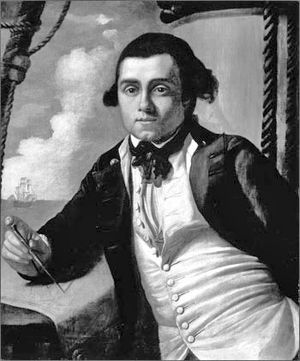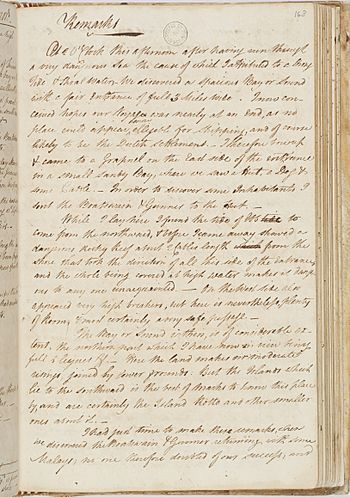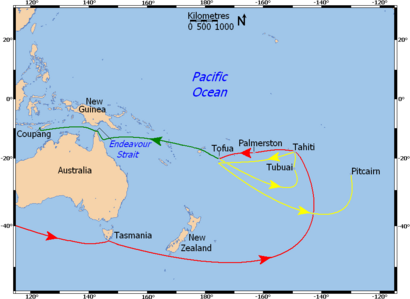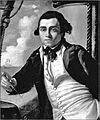William Bligh facts for kids
Quick facts for kids
Vice-Admiral of the Blue
William Bligh
|
|
|---|---|

Portrait by Alexander Huey (1814)
|
|
| 4th Governor of New South Wales | |
| In office 13 August 1806 – 26 January 1808 |
|
| Monarch | George III |
| Lieutenant | William Paterson |
| Preceded by | Philip Gidley King |
| Succeeded by | Lachlan Macquarie |
| Personal details | |
| Born | 9 September 1754 Plymouth, Devon, (or St Tudy, Cornwall), England |
| Died | 7 December 1817 (aged 63) 25 Bond Street, London, England |
| Resting place | St Mary-at-Lambeth, Lambeth, London, England |
| Spouse |
Elizabeth Betham
(m. 1781; died 1812) |
| Children | 8 children, including Mary Putland |
| Occupation | Naval officer, colonial administrator |
| Military service | |
| Branch/service | Royal Navy |
| Years of service | 1761–1783 1787–1817 |
| Rank | Vice-Admiral of the Blue |
| Battles/wars | |
| Awards | Naval Gold Medal |
Vice-Admiral William Bligh (9 September 1754 – 7 December 1817) was a British officer in the Royal Navy. He was also a colonial administrator. He is most famous for the mutiny on HMS Bounty in 1789. This happened when the ship was under his command.
After the mutineers set him adrift, Bligh and his loyal crew sailed over 3,600 nautical miles. They reached Timor safely. Bligh's detailed logbooks about this journey are very important. They were added to the UNESCO Australian Memory of the World register in 2021.
Seventeen years after the Bounty mutiny, Bligh became Governor of New South Wales in Australia. He was ordered to stop illegal trading. His actions led to the Rum Rebellion in 1808. During this event, Bligh was arrested and removed from his position. The British government later said this was illegal. He passed away in London in 1817.
Contents
Who was William Bligh?
William Bligh was born on 9 September 1754. His exact birthplace is not known for sure. He was likely born in Plymouth, Devon. He was baptized there in October 1754. His father was a customs officer in Plymouth. Bligh's family also had a home in St Tudy, Cornwall.
Bligh joined the Royal Navy when he was only seven years old. It was common then for young boys to join to gain experience. This experience was needed to become an officer later. In 1770, at age 16, he became an able seaman on HMS Hunter. He became a midshipman the next year.
Joining Captain Cook's Voyage
In 1776, Bligh was chosen by Captain James Cook for an important role. He became the sailing master of Resolution. He joined Cook's third voyage to the Pacific Ocean. During this trip, Captain Cook was killed. Another captain, Charles Clerke, took over but was very ill.
Bligh became the main navigator for the expedition. He helped guide the ships back to England in 1780. He also shared important details about Cook's last voyage.
In 1781, Bligh married Elizabeth Betham. They had eight children, including six daughters. Soon after his wedding, Bligh served on Belle Poule. He fought in the Battle of Dogger Bank. This battle earned him a promotion to lieutenant. He also fought at Gibraltar in 1782.
From 1783 to 1787, Bligh worked as a captain in the merchant navy. It was hard to get a job in the Royal Navy after the war ended. In 1787, he was chosen to command HMS Bounty. He eventually rose to the rank of vice admiral in the Royal Navy.
The Famous Bounty Voyage
The most famous event in William Bligh's life was the mutiny on HMS Bounty. This happened in the South Pacific Ocean on 28 April 1789.
Why did the Bounty sail?
In 1787, Lieutenant Bligh took command of HMAV Bounty. His mission was to sail to Tahiti. There, he would collect breadfruit trees. These trees were meant for the West Indies. The idea was to see if breadfruit could be a good food source for people working on plantations there.
The journey to Tahiti was very difficult. The Bounty tried to sail west around Cape Horn in South America. But the weather was too stormy. So, the ship had to take a much longer route around Africa. This delay meant Bligh had to wait five months in Tahiti. He waited for the breadfruit plants to grow enough to be moved. The Bounty left Tahiti in April 1789.
What happened during the Mutiny?
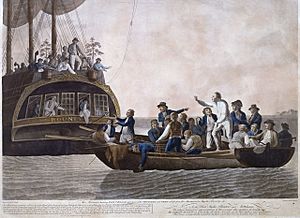
The Bounty was a small ship, like a cutter. It had only one commissioned officer, Bligh himself. There were no Royal Marines on board for protection or to keep order. To help his crew get more sleep, Bligh divided them into three watches. He put his friend, Fletcher Christian, in charge of one watch.
The mutiny happened on 28 April 1789, during the return journey. Christian led 18 crewmen. They took firearms during Christian's night watch. They surprised Bligh in his cabin and tied him up.
Even though Bligh had more loyal men, no one fought back much. The ship was taken over without violence. The mutineers put Bligh and 18 loyal crewmen into a small, open boat. It was a 23-foot launch. The boat was so full that its sides were only inches above the water. They were given four cutlasses, some food and water, a quadrant, and a compass. But they had no maps or marine chronometer.
The launch could not hold everyone. So, four loyal crew members were kept on the Bounty. They were later released in Tahiti. Bligh and his men first tried to get supplies at Tofua. But they were attacked by local people, and one crewman was killed. Bligh did not stop at other islands because he had so little defense.
Bligh's Incredible Journey
Bligh trusted his navigation skills. He had learned them from Captain Cook. His main goal was to get his men to safety. He decided to sail to Timor, a European settlement over 3,600 nautical miles away.
Bligh succeeded in reaching Timor after a 47-day journey. The only person lost was the crewman killed on Tofua. For weeks, the 18 men lived on tiny amounts of bread each day. The weather was often stormy, and they feared the overloaded boat would sink.
On 29 May, they landed on a small island off Australia. They named it Restoration Island. Bligh, always mapping, sketched the coast as they sailed north. They reached Coupang, Timor, on 14 June 1789. Sadly, three men died from sickness in Batavia (now Jakarta) while waiting for a ship home. Two more died on the way to England.
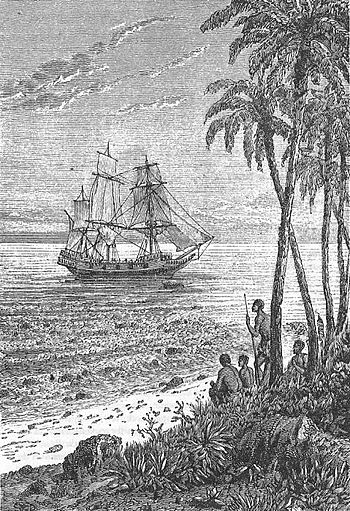
Why did the Mutiny happen?
The exact reasons for the mutiny are still debated. Some say Bligh was a harsh captain. They believe his treatment of the crew made them mutiny. Others argue that Bligh was not worse than other captains of his time. They suggest the crew, especially after five months in Tahiti, did not want to return to naval life.
This view suggests that many men supported Christian's actions. They hoped their new captain would take them back to Tahiti. There, they could live freely, away from Bligh's strict rules.
Bligh's ship log shows he was not overly harsh with punishments. He would scold when others might whip. He was also interested in science and his crew's health. He made sure they exercised and ate well. He also insisted the Bounty be kept very clean.
However, Bligh had a flaw. He could be very critical and insult people easily. He also held grudges against those he felt had betrayed him.
What happened after the Mutiny?
In October 1790, Bligh was cleared of any blame for losing the Bounty. He then published a book about the mutiny and his incredible journey. Of the 10 mutineers who were eventually caught and brought to trial, four were found not guilty. Bligh's testimony helped them. Two others were found guilty but pardoned. One was found guilty but excused on a technicality. The remaining three were found guilty and hanged.
- Journeys of Bounty and Bligh's boat
|
|
|
Second Breadfruit Voyage
After being cleared of blame, Bligh stayed in the Royal Navy. From 1791 to 1793, he commanded HMS Providence. He went on another mission to transport breadfruit from Tahiti to the West Indies. This trip was successful in moving the plants. However, the main goal of providing cheap food for enslaved people was not met. Most people refused to eat the new food.
During this voyage, Bligh also collected samples of the ackee fruit from Jamaica. He introduced it to the Royal Society in Britain. The ackee's scientific name, Blighia sapida, honors William Bligh.
In 1797, Bligh was captain of HMS Director. He helped map the Humber estuary in England. In April and May of that year, his crew was part of the widespread Spithead and Nore mutinies. These mutinies were about pay and service conditions for sailors. Bligh's ship was the last to end its part in the mutiny.
As captain of Director, Bligh fought in the Battle of Camperdown in October 1797. He fought against three Dutch ships. For his bravery, Bligh received the Naval Gold Medal.
Bligh also served under Admiral Nelson at the Battle of Copenhagen in 1801. He commanded Glatton. Nelson praised Bligh for his help in the victory. Bligh was the only captain who could see Nelson's signal to continue fighting. By following Nelson's signal, he ensured his ships kept fighting.
In May 1801, Bligh became a Fellow of the Royal Society. This was for his important work in navigation and botany.
Governor of New South Wales
Bligh was known for being a strict leader. Because of this, he was offered the job of Governor of New South Wales. He was appointed in March 1805 and arrived in Sydney on 6 August 1806. He became the fourth governor of the colony.
His wife, Elizabeth, did not want to make the long sea journey. So, Bligh was joined by his daughter, Mary Putland. She became the Lady of Government House. Mary's husband, John Putland, became Bligh's assistant.
The Rum Rebellion
In Sydney, Bligh's strict leadership caused problems with powerful settlers and officials. These included wealthy landowner John Macarthur. It also included important government figures like the colony's main surgeon, Thomas Jamison. Jamison and his military friends were making money from illegal trading. Bligh was determined to stop this.
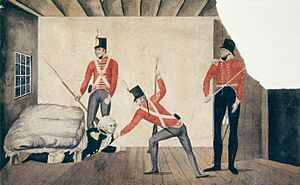
The conflict between Bligh and these powerful people led to another mutiny. This was called the Rum Rebellion. On 26 January 1808, 400 soldiers marched on Government House in Sydney. They arrested Bligh. A new government was put in place. Bligh, now removed from power, sailed to Hobart in Tasmania. He was held on HMS Porpoise from 1808 until 1810.
Soon after Bligh's arrest, a cartoon showing the event was displayed in Sydney. It showed a soldier pulling Bligh from under a bed. This cartoon was Australia's first political cartoon. It used exaggeration to make Bligh look like a coward. This was to show that the soldiers thought he was not fit to govern.
Interestingly, Bligh cared about the newer, less wealthy settlers in the colony. Many boys born around 1807 to 1811 in areas west of Sydney were named "William Bligh." This shows that some people supported him. For example, Malcolm Bligh Turnbull, a former Prime Minister of Australia, is a descendant of one such child.
After the Rebellion
In January 1810, Bligh received a letter. It said the rebellion had been declared illegal. The British government called it a mutiny. Lachlan Macquarie was appointed as the new governor. Bligh then sailed back to Sydney to gather evidence for a trial in England. He left for England on 12 May 1810.
His daughter, Mary Putland, married the new Lieutenant-Governor, Maurice Charles O'Connell. She stayed in Sydney. Major Johnston, who led the rebellion, was later found guilty. He was removed from his military position without pay. This was a mild punishment. Bligh was cleared in two more court-martials during his career. Soon after Johnston's trial, Bligh was promoted to rear admiral. In 1814, he became vice-admiral of the blue. He did not receive another important command after this.
Final Years and Legacy
Bligh was asked to map Dublin Bay in Ireland. He suggested building walls for a harbor there. The large harbor built later was called Kingstown, now Dún Laoghaire. Many people believe Bligh designed the North Bull Wall in Dublin. He did propose a sea wall to clear a sandbar. However, a different design was used for the wall that created North Bull Island.
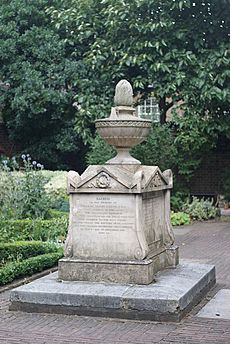
William Bligh died from cancer in London on 7 December 1817. He was buried in a family plot at St. Mary's, Lambeth. This church is now the Garden Museum. His tomb is special because it uses Coade stone. This is a special material that looks like carved stone. The tomb has an eternal flame on top. A plaque marks Bligh's house in London.
Bligh was related to other naval officers. His family in Britain and Australia includes important figures like Anna Bligh, a former Premier of Queensland. The suburb of Bligh Park in New South Wales is named after him. This is because the settlers there supported him during the Rum Rebellion.
Images for kids
-
The mutineers turning Lt Bligh and some of the officers and crew adrift from His Majesty's Ship HMS Bounty. By Robert Dodd
-
Original illustration by S. Drée from French author Jules Verne's story The Mutineers of the Bounty (1879).
-
Propaganda cartoon of Bligh's arrest in Sydney in 1808, portraying him as a coward. State Library of New South Wales, Sydney.
-
Bligh's tomb, surmounted by an eternal flame, sits in the Sackler Garden at the Garden Museum.
See also
 In Spanish: William Bligh para niños
In Spanish: William Bligh para niños
- European and American voyages of scientific exploration
- Historical Records of Australia


